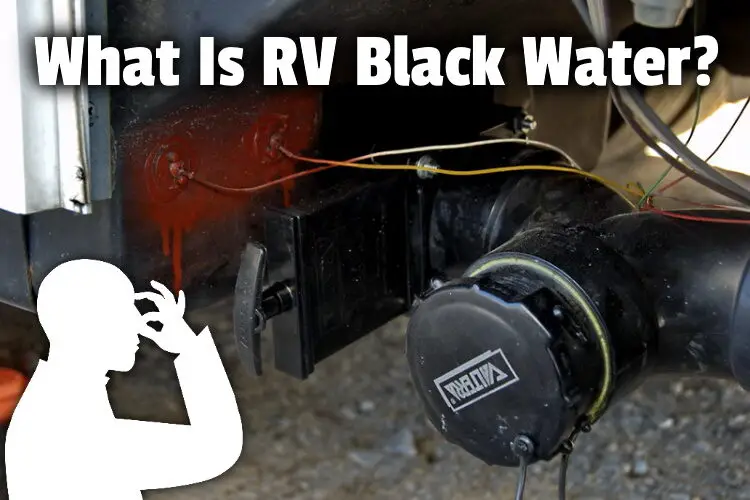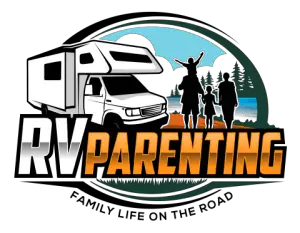
New RV owners hear a lot of new terms, including words like black water and gray water. This has some people wondering what the difference is and specifically what is RV black water?
Here’s what I know from owning and renting RVs for years:
RV Black water refers to the water that drains from the RV’s toilet. So the black water tank holds all the water, urine, and fecal matter from the toilet.
But that’s not all there is to know about black water.
After all, there are other questions to be answered such as what is gray water, how long can you go before dumping your tanks, and do you need to do anything special to keep them clean?
In this article, we’ll discuss everything you need to know about the two.
So let’s get to it.
Day 1 driving done! Made it to the campground. Only had to stop a few times to reconnect the black water tank when Tony ran over tires on the road. 🤢. #RVforMLB RV life is glamorous pic.twitter.com/lFy3jFOyqz
— Mike, Tony and Eric (@pandemicRV4MLB) June 1, 2020
What is the difference between black and gray water?
Gray water is everything that goes down an RV’s sink drains and shower drain. Black water is everything that goes down the RV’s toilet.
RVs typically come with three tanks: fresh water, gray water, and black water. The fresh water tank is the holding tank for fresh water. This is the water that comes out of your tap for washing and drinking.
The gray water tank holds the dirty water from your shower, bathroom sink, and kitchen sink. If you have a washing machine, it also produces gray water.
Your black water tank holds waste from the toilet. Coming in contact with black water is hazardous for your health, and emptying the tank should be handled with care.
All of your tanks should be maintained properly in order to avoid problems.
You really shouldn’t leave the matter in your black water tank for more than a week. And it should be emptied once it reaches ⅔ full and/or at the end of your trip.
To read more about how long you can keep black water in your tank, read this recent article. If you’re boondocking or doing any sort of dispersed camping, it makes sense to go as long as possible before emptying the tanks. But there’s 1 trick to maximizing that.
Just click the link to read it on my site.
Attach the sewer hose to the RV and into the dump station hole, pull open the black water tank valve first.
If your RV has a black tank rinse system now is the time to connect it up and rinse out the black tank, then open the grey tank. pic.twitter.com/lzZ8AuTF3M— Family RV Group (@FamilyRVGroup) February 4, 2020
How do I get rid of black water in my RV?
Here are the exact steps for dumping RV black and gray water:
- Put on latex gloves or other washable work gloves
- Connect a high-quality sewer hose to the outlet drain of the RV’s black and gray water tanks. Typically there will be 1 drain outlet for both tanks
- Connect the other end to the dump station or RV campground inlet.
- You’ll see two gate valves. One is for the black water, and one is for the gray water. Always drain the black water first.
- Pull the black water valve and let the tank drain completely.
- Next, close the valve and drain the gray water. The gray water will help clean out anything that may have gotten stuck in the hose. When both tanks are empty, ensure that both valves are tightly closed.
- Disconnect from the RV first, and then the dump connection. You may even want to run some freshwater through the hose before you disconnect from the dump station. Return your hose to its storage location, and you’re done!
If you’re just starting out RVing, you may not know much about how your water pump works. Leaving your water pump on isn’t necessarily bad for your RV. But it’s not necessary if you’re connected to a water supply at the campground.
For a more thorough explanation of how your water pump works and how long you can leave it on, check out this recent article. I get into when you need the pump on when you don’t, and the 1 sure-fire way to break the pump!
Just click the link to read it on my site.
RecPro understands how vital fresh water, gray water, and black water storage can be to a recreational vehicle. That’s why we offer one of the largest, and widest, selections in the aftermarket industry of tanks available for RVs, trailers, and food trucks. #RV #RVLIFE #RVTANKS pic.twitter.com/vvlKvUefsA
— RecPro (@RecProUSA) February 4, 2019
Can you put bleach in an RV black water tank?
Pour a small amount of bleach down the toilet bowl to clean and sanitize the black water drain lines and tank. Additionally, adding 1 pouch of black water tank cleaner after draining and before storing the RV will help reduce build-up and maintain a clean tank.
Over time, your black water tank will begin to smell, even if you empty it regularly. This is caused by bacteria and waste products building up in your tank.
Even if you use the proper cleaning chemicals in your tanks, it is a good idea to thoroughly clean and sanitize your gray and black water tanks and flush the sewer hose every so often.
You can clean and sanitize your holding tanks by filling them with a bleach and water solution. Fill your tank with clean water. For every gallon of water, add one-quarter cup of bleach to your tank. So, if you have a 16-gallon tank, you need to add 4 cups of bleach.
Completely fill your tank with this solution, and let it sit overnight. Or at least for 8 hours. Even better, fill the holding tank before you go on a long trip. This will give the solution a chance to swish around and really clean the inside of your tank.
Just dump it at the dump station when you arrive at the campground.
You can and should do this for both your black water tank and your gray water tank. Both can get smelly over time. For RV black water tank cleaning pouches, I really love this one on Amazon.
Over 800 ratings, an Amazon’s Choice product, and almost all reviews are 5-star. So it really can’t be beaten! Just click that link to see the current price on Amazon.
RV toilet chemicals help breakdown bacteria and enzyme compositions that are added into your black water tank which helps break down waste and tissue and not to mention unwanted odors! #RVTrailerSupply #RV #ElCajon #CA pic.twitter.com/0TOJ6GxPga
— RV Trailer Supply (@TrailerRv) April 24, 2020
How long will a 30 or 40-gallon black water tank last?
A 40-gallon black water tank can last for more than 15 days for 1 person or up to 7 days for a family of 4. A 30-gallon tank will last 11 days for 1 person or 5 days for a family of 4.
Depending on how you use it, your black water tank can last quite a long time. Of course, the less you use it, the longer it will last.
Let’s say you have two people RVing. If each person uses one gallon of space, your 40-gallon black water tank will last 20 days. But that’s going to require some conservation efforts.
The easiest way to conserve space is to use the facilities at the campground. Otherwise, just be careful with how much water you are using when you flush the toilet.
Conserving water and space in your black water tank is especially important when dry camping. You can typically dry camp for up to 14 days before you need to dump your tanks, charge your batteries, or add fuel to the generator.
But if you are new to RVing, you may want to try it for a few days first, until you get more familiar with camping and with your RV. There aren’t many things that are worse than an overflowing black water tank!
To read more about how long you can dry camp in an RV, check out this recent article. I not only get into different tank sizes, battery power, and the different energy usages of different appliances.
Just click the link to read it on my site.
Who has two thumbs and did NOT have to empty the black water/grey water out of the RV?
👍🏼THIS GUY 👍🏼 😂 🚽 pic.twitter.com/S6wAUo7eRM
— Brent Sasaki (@brentsasaki) November 19, 2020
Can you dump RV black water at home?
For those with a septic system or grinder pump, simply run the RV drain hose into one of those systems. But for most homeowners, there is not an approved and sanitary way to dispose of black water at home.
So, yes, you can, but there are some things you need to know first. Dumping at home can be convenient, but it may not be the best option for everyone.
First and foremost, check your local ordinances.
If you are on city water, or if you live in a neighborhood with an HOA, it may be against the rules, or the law, to dump RV waste into a residential sewer system.
If you have a home septic system, it’s super easy to dump your waste at home.
Just look for the system’s cleanout. It’s a big PVC pipe sticking out of the ground with a screw-on cap. If you don’t have one, then look for your system’s access port.
Make sure that you are on the solid waste side of your system’s baffle.
If you dump on the wrong side of your septic, you can cause significant problems. I’m talking about the kind of problems that can cost thousands of dollars to repair. That will make dumping at home inconvenient for sure.
Finally, when dumping at home, don’t use any chemicals in your RV black tank. Those chemicals can kill off any good bacteria in your septic tank.
If you are on city septic, and you can’t dump directly into the septic system, you can grind up the contents of your holding tank with a macerator.
Then you can use a pump to flush it through a garden hose directly into your home toilet. It’s tedious, but it can be done.
Just make sure to either mark the water hose or store it somewhere out of the way. You don’t want to use the same hose to play in the sprinkler or fill up your swimming pool in the summer.
Did I answer everything you wanted to know about RV black water?
Black water really isn’t as scary as it sounds.
Wear gloves when you empty your tank, and sanitize the tank every so often.
Dumping your gray water right after you dump your black water will help prevent waste from building up in the hose and keep it somewhat clean.
You can dump your black water at home, but make sure you are doing it properly and following local rules and regulations. A macerator pump can be a handy little device if you regularly pump into sewer drains or toilets.
Photo which requires attribution:
RV Sewer Dump Valve by Dave Bezaire is licensed under CC2.0
